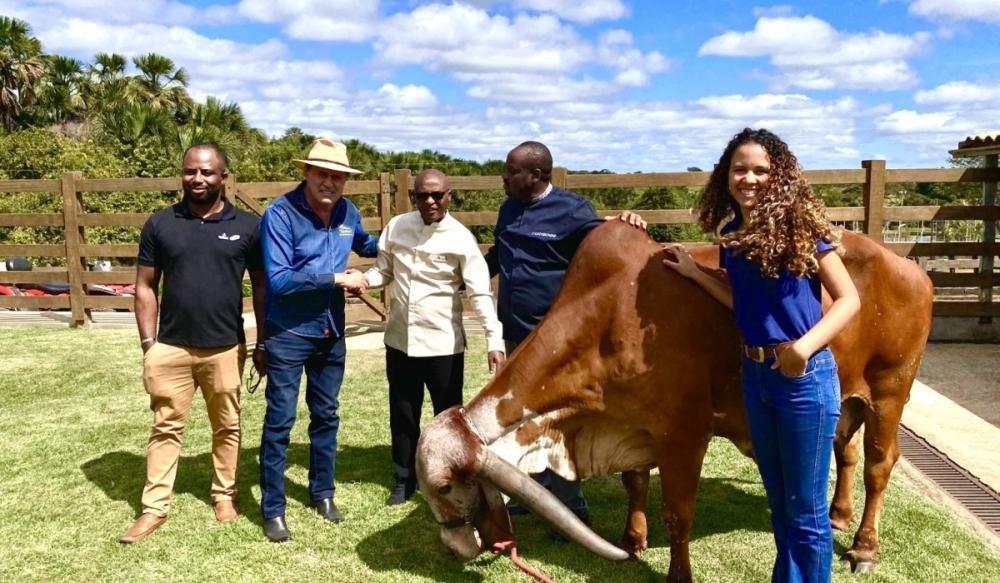Africa-Press – Rwanda. The government is banking on embryo transfer technology to accelerate the introduction of Girolando cattle, a Brazilian-developed dairy breed prized for its high milk yield and climate resilience as part of its strategy to transform the dairy sector, according to industry actors.
Embryo transfer is a process in which a fertilised egg from a donor cow is implanted into the uterus of a recipient or surrogate cow to achieve pregnancy and birth.
Known for its high milk yield and adaptability to tropical or adverse weather conditions, Girolando is now at the centre of Rwanda’s dairy transformation agenda.
Girolando is a tropical dairy breed developed in Brazil by crossbreeding Gir, which is a cow breed from India, and Holstein Friesian breed from the Netherlands.
It combines the high milk yield of Holstein with the heat tolerance, disease resistance, and adaptability of Gir, making it well-suited to Rwanda’s agro-ecological conditions, Solange Uwituze, Acting Director General of Rwanda Agriculture and Animal Resources Development Board (RAB), told The New Times.
Regarding milk yield, she said that a Girolando cow can produce on average 20–30 liters of milk per day under good management, significantly higher than the local average of 8 – 12 litres.
“By introducing Girolando, Rwanda expects to boost national milk production, strengthen the dairy value chain, and increase farmers’ incomes. The breed’s adaptability also makes it more resilient to climate change, ensuring sustainable growth of the dairy sector,” she said of the expected impact.
The need for embryo transfer
From around 2022, Uwituze said, Rwandan dairy farmers got interested in rearing Girolando cows for milk production.
The government, through RAB, imported Girolando conventional semen in 2023. Semen was inseminated across the country and the first calves with 50 per cent Girolando genetics were born starting in September 2024. Uwituze pointed out.
Rwanda has opted for embryo transfer because it is the fastest and most efficient method of introducing and multiplying high-genetic merit Girolando cattle, Uwituze said.
Unlike conventional artificial insemination which achieves 50 per cent of the breed and brings Girolando genetics gradually over generations, she indicated, embryo transfer will allow the country to introduce pure bred Girolando by implanting the breed embryos into local recipient cows.
“This approach will accelerate genetic gain, ensure uniformity of the resulting Girolando cows, and support the establishment of a nucleus herd that can later supply genetics to other dairy farmers in Rwanda and in the region,” she stated.
Peter Twahirwa, a dairy farmer from Nyagatare District in Eastern Province, told The New Times that the relatively high cost and logistical challenges of importing live Girolando cows make it difficult for many farmers to access this highly productive breed.
He praised Girolando cows for their desirable traits, including high milk yields and strong resistance to diseases.
He underscored the need for assisted reproductive technologies to expand access among local farmers.
“If embryo transfer is implemented successfully, it could make a big difference, as it would allow dairy farmers to access purebred Girolando cows,” he said.
Why embryo transfer?
While speaking during Prime Minister Justin Nsengiyumva’s visit to RAB’s Songa cattle genetic improvement centre in Huye District, on September 23, Uwituze said that the entity plans to start producing embryos at the facility.
Embryo production technology is intended to rapidly increase the offspring of genetically superior cows, including the Girolando breed.
She also said that they want to start producing sexed semen technology, which allows for selecting the sex of the offspring –aiming for heifers or bulls – with around 95 per cent accuracy.
“If everything goes to plan, we expect that by the end of 2026, we will have launched embryo production and sexed semen technologies, building on the ordinary artificial insemination already being practiced,” she said.
Through such a technology, she said, “we want to take a cow that would normally produce one heifer every two years and, through embryo technology, enable it to produce more than 10 calves per year,” she explained.
According to the Minister of Agriculture and Animal Resources, Mark Cyubahiro Bagabe, a single donor cow – Gir being the primary target – can help produce around 48 embryos per year, which can then be implanted into surrogate or recipient cows to give birth to Girolando calves. The average success rate for embryo transfer, he said, is about 30 per cent.
Uwituze pointed out that the country plans to import Gir cows as donors, from which ova will be collected. These will be fertilised with semen from Friesian bulls already available in Rwanda, hence producing Girolando embryos.
The embryos will then be transferred into local cows – as surrogates – which will give birth to Girolando calves.
The embryo production process involves stimulating a donor cow to produce multiple eggs – a technique known as multiple ovulation or superovulation.
These eggs are then fertilised with semen from a selected breed, such as Girolando, either in a lab (in vitro) or inside the cow (in vivo). The resulting embryos are cultured to a viable stage before being transferred into the uteruses of recipient cows to carry the pregnancy to term.
The New Times has learned that, for animal welfare, the recommended best practice is to collect ova or embryos from a donor cow not more than four times per year.
What it will take to establish a high-genetic merit Girolando cattle nucleus herd
Uwituze said that establishing a Girolando nucleus herd will require the following steps:
• Importation of embryos from carefully selected elite donor cows from Brazil.
• Trained veterinarians and technical teams to carry out embryo transfer.
• Adequate infrastructure for breeding, recording, and performance monitoring of Girolando calves born from Embryo transfer.
• Partnerships between government and private farmers to host and manage nucleus herds.
“The process is being initiated in this 2025-2026 fiscal year, and the first nucleus herds are expected to be established within the next two – three years. The overall budget is being finalised jointly with the Ministry of Agriculture and Animal Resources and partners, covering embryo importation, technical expertise, and farm infrastructure,” Uwituze stated.
Parallelly, she said, there are some farmers interested in importing Girolando heifers, and the Ministry of Agriculture and Animal Resources is supporting them with all the required information and import permits.
Girolando embryo, cow imports under consideration
Meanwhile, Uwituze indicated that the number of embryos to be imported and all technical assistance are being discussed with partners in Brazil. For heifers, she said, the ministry was coordinating expression of interests about the numbers of cows each farmer would like to buy and similarly engaging the Brazilian suppliers.
Minister Bagabe said farmers have registered interest in importing Girolando cows – which amounted to about 400 cows as of September 23.
He indicated that the ministry was working on a coordinated system where all farmers contribute through a single bank account – to facilitate bulk importation.
Some suppliers have quoted prices of up to $8,000 (about Rwf11 million) per pregnant Girolando cow, upon delivery to Kigali by air, Bagabe said, adding that the ministry was exploring ways to get them at a lower cost, in partnership with Rwanda’s Embassy in Brazil.
Rwanda targets to increase milk production from more than 1.09 million tonnes in 2023/24 to more than 1.3 million by 2028/29, under the fifth strategic plan for agriculture transformation (PSTA 5).
For More News And Analysis About Rwanda Follow Africa-Press






